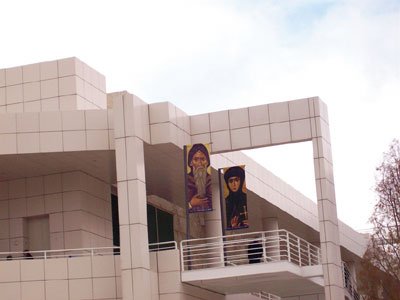We are all familiar with icons in advertising, those images of a
bitten apple or golden arches that immediately remind us of
products. But the use of icons vastly predates the industrial
age.
We are all familiar with icons in advertising, those images of a bitten apple or golden arches that immediately remind us of products. But the use of icons vastly predates the industrial age.
For early Christians, icons were flat pictures, painted on various media, representing in a stylized way Christ, the Blessed Virgin Mary or another saint. They are venerated in the Greek and Russian Orthodox traditions because it is believed that “through them the saints exercise their powers … and are powerful channels of grace.”
From November 2006 through last Sunday, a magnificent exhibit of rare icons was on display at the J. Paul Getty Museum at the Getty Center in Los Angeles. Visitors to “Holy Images, Hallowed Ground: Icons from the Sinai” had a unique opportunity to learn about this important art form and the spirituality it represents.
This exhibit contained 53 works on loan from the Holy Monastery of St. Catherine at Mt. Sinai in Egypt. This isolated institution, located along trade routes connecting Byzantium, the Holy Land and Western Europe, is the world’s oldest continuously operating Christian monastery. Standing at the foot of the mountain where Moses is said to have received the tablets containing the Ten Commandments, the present church and monastery walls date from the sixth century. It is the world’s largest repository of Byzantine icons.
The exhibition examined the traditions of St. Catherine’s icons in three sections.
– An explanation of icons as holy objects: On view were paintings depicting biblical scenes and individual saints, with information about how and why they were created.
– An examination of the role of icons in prayer and liturgical life: An area of the exhibit hall was designed to represent the basilica (church) at St. Catherine’s, showing how these religious objects serve to “sanctify the space.”
– A description of the monastery as a pilgrimage magnet, drawing visitors from around the world over the centuries: It included a manuscript from a seventh-century abbot, images of Moses and the martyrdom of St. Catherine of Alexandria, an illuminated manuscript written in Arabic, and icons done by artists from the West during the Crusades.
There was also a 10-minute film showing contemporary worship at St. Catherine’s during Holy Week, a special time of elaborate worship. Several priests and monks were interviewed for their perspectives on this holy site.
The Getty Center hosted a large number of events supplementing the exhibit:
– Lectures on liturgy, icons, and pilgrimage traditions
– A course in the art of egg tempera painting, a popular method of creating icons
– A seminar on illuminated manuscripts, an important art form in the Middle Ages
-n A concert of Byzantine music
– A lavishly illustrated catalogue from the exhibit explains icons’ status as holy objects, ways in which icons sanctify places of worship, and how monks sought holiness. It is available for $75 (hardcover) or $50 (paperback) from the museum (1200 Getty Center Drive No. 1000, Los Angeles, CA 90040 or on the Internet at www.getty.edu).
A visit to the Getty Center is a treat in itself. Located atop hills overlooking the Pacific Ocean, it is a magnificent complex of stunning buildings, remarkable gardens and amazing artworks, inside and outside. Admission is free ($8 parking in the underground garage from which visitors are transported via electric tram to the museum itself).













